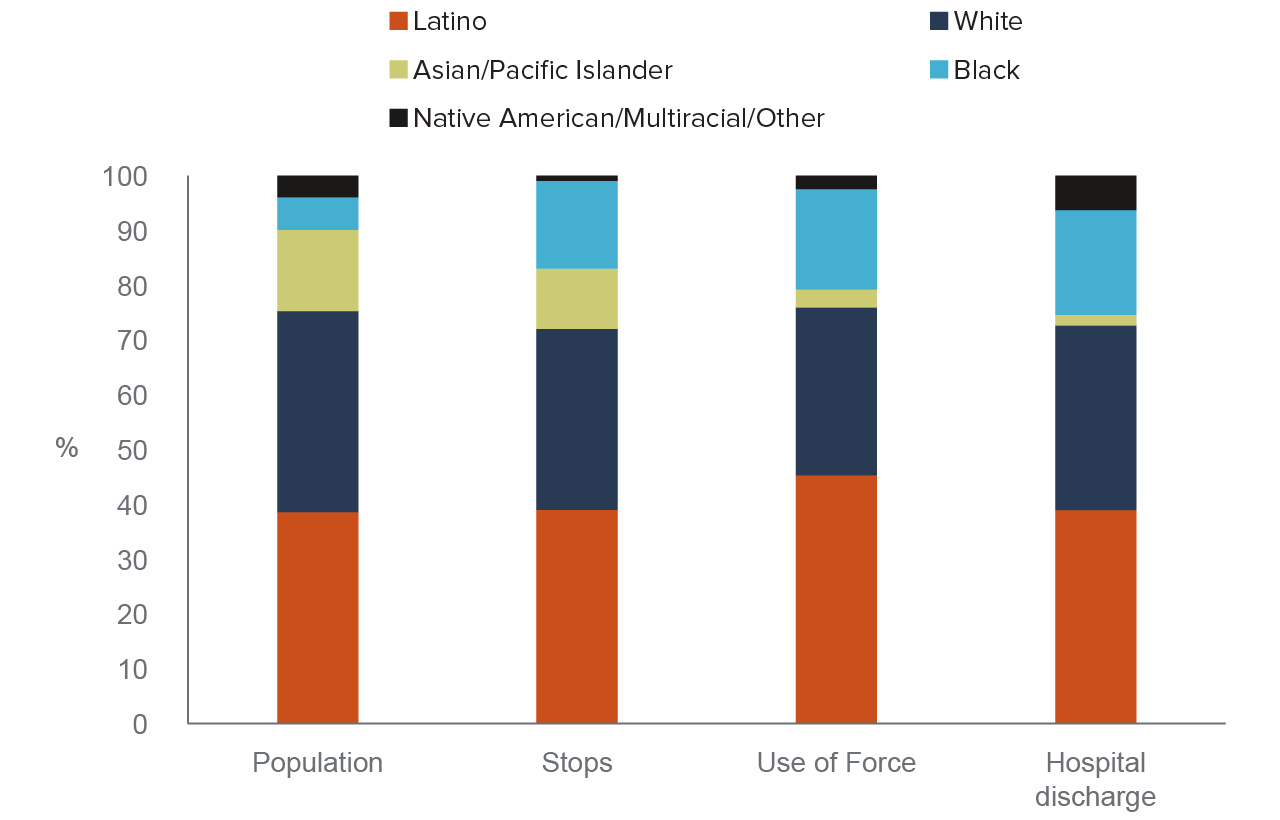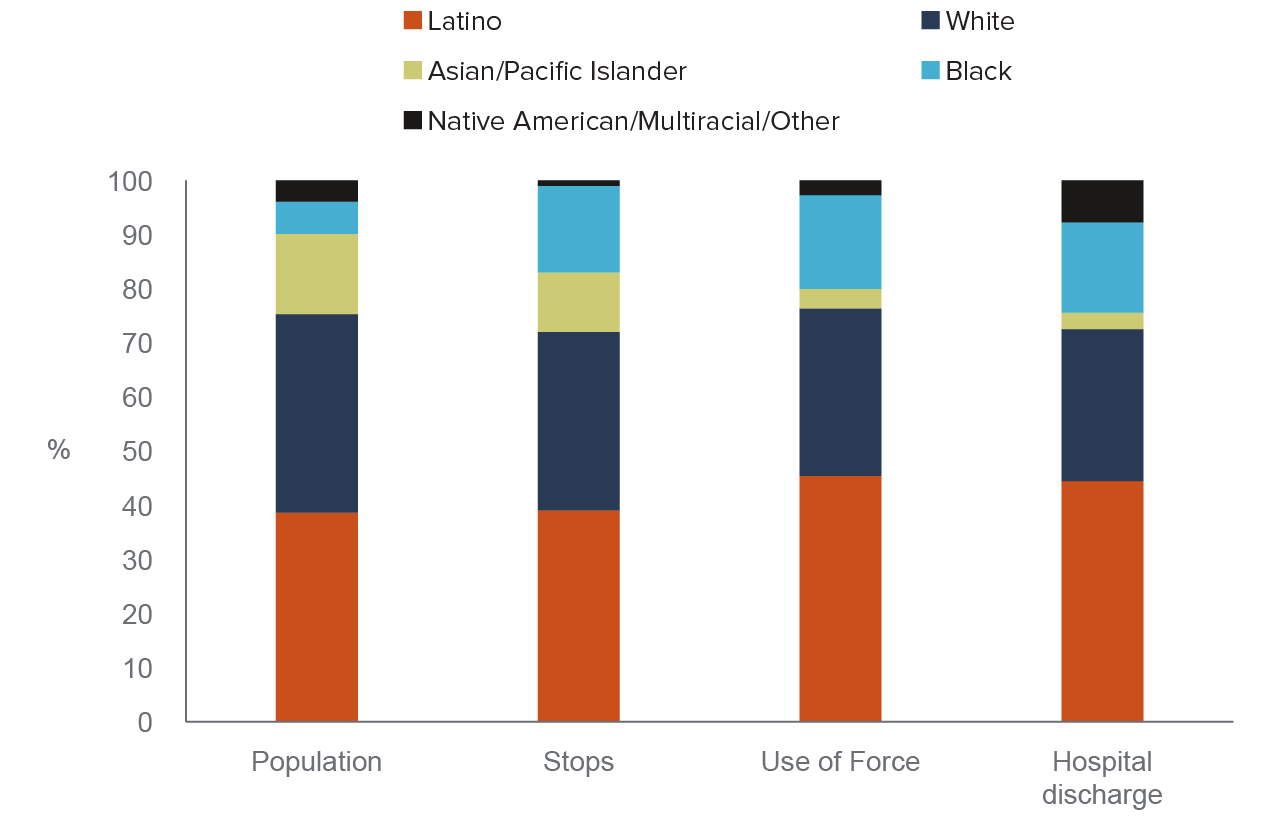Table of Contents
Key Takeaways
Over the past decade, the high-profile deaths of civilians—especially Black civilians—at the hands of law enforcement have heightened public scrutiny over policing and created momentum for state reforms. In this report, we examine the available data to provide a baseline understanding of police use of force and misconduct in California. While most use-of-force incidents are not considered misconduct, civilian fatalities and injuries—particularly of unarmed individuals—can nevertheless harm the public’s trust in law enforcement. All parties should be aligned in accurately documenting these incidents and reducing their frequency.
- About 195 people die each year from interactions with California law enforcement. Gunshots are by far the most common cause of death: nearly 250 people are shot by police each year. →
- Vehicle and pedestrian stops account for about 15 percent of police encounters in which a civilian is seriously injured or killed. →
- More than four in ten people treated for non-fatal gunshot wounds from a police encounter were diagnosed with a mental health condition, an alcohol- or substance-related disorder, or both. →
- In about 80 percent of encounters resulting in death or a gunshot wound, the civilian was armed with a weapon, underscoring the risky environments officers face. However, when we also consider civilians who sustained other serious injuries, 56 percent were unarmed. →
- Black Californians are about three times more likely to be seriously injured, shot, or killed by the police relative to their share of the state’s population. These racial disparities narrow after controlling for contextual factors (e.g., the reason for the interaction), but continue to persist. →
- Of the over 78,000 law enforcement officers in California, about 80 are arrested each year; assault is the most common reason for arrest. Data on arrested officers do not capture the full range of police misconduct. →
- Improving existing data sources will be vital to shed more light on police use of force and misconduct in California. →
Introduction
In the summer of 2020, the murder of George Floyd by a Minneapolis Police Department officer precipitated widespread protests and amplified calls for policing reform. This killing came after years of high-profile deaths of Black civilians—including Michael Brown, Eric Garner, and Stephon Clark, among others—during encounters with police, and refocused efforts among policymakers at all levels of government to increase police accountability and transparency.
At the federal level, Congress was considering major reforms related to policing practices and law enforcement accountability, though legislators were unable to reach an agreement on a final bill. The George Floyd Justice in Policing Act would have, among several other provisions, established national standards for police use of force, required state and local law enforcement agencies to report use-of-force data, and created a nationwide registry for police misconduct to make it more difficult for officers to change jurisdictions after committing misconduct.
In the last several years, California has already implemented many reforms through state legislation, including requiring local law enforcement agencies to report incidents of serious use of force, permitting public access to law enforcement records for certain misconduct and use-of-force incidents, and establishing an independent board and data collection effort aimed at reducing racial disparities in police encounters. To support these efforts, in 2015 the California Department of Justice (DOJ) launched OpenJustice, an online data repository designed to “strengthen trust, enhance government accountability, and improve public policy in the criminal justice system.” More recently, Governor Newsom signed several bills on policing reform, including the creation of a decertification process for officers who have committed serious misconduct and expanding access to police misconduct records.
Given the inherent risks of working in law enforcement, officers are legally able to use force—including physical restraints, Tasers, blunt force objects like batons, and firearms—when needed to restore safety, make an arrest, and/or protect themselves or others from harm. While use of force is one of many tools afforded to officers to perform their duties, there are distinctions made when this force becomes “excessive” or “unreasonable” given the circumstances of the situation. However, the delineation between reasonable and excessive force is not always clear, and there is no universal set of rules governing when or how officers should use force (National Institute of Justice 2020). The legal standard to evaluate whether excessive force merits criminal charges has changed as well. In 2019, the California State Legislature passed Assembly Bill 392, which changed the standard for deadly force from when reasonable “to effect an arrest” to when “necessary to defend against an imminent threat of death or serious bodily injury to the officer or to another person.”
An officer’s decision to use force may be related to many different contextual factors. Some of these factors include the officer’s level of training and experience, the reason for the encounter (e.g., a crime in progress or a pedestrian/vehicle stop), and whether the civilian is armed and/or putting the officer or others at imminent risk. In addition, behavioral health conditions like mental illness and/or substance use may contribute to a civilian’s erratic behavior or inability to follow verbal commands, which can escalate a police encounter.
Police misconduct refers to incidents in which an officer’s actions are deemed outside of the code of conduct. While excessive use of force is grounds for misconduct, for which an officer may be disciplined or face criminal charges, most cases of use of force are considered legally and procedurally justified. It is also important to keep in mind that misconduct may occur while an officer is off duty and may not involve the use of force at all (e.g., obstructing justice, driving under the influence, or engaging in other illegal acts).
Even in cases where police use of force is considered legally justified, civilian deaths and injuries resulting from police encounters—particularly those of unarmed individuals—remain deeply concerning. These incidents clearly have serious consequences for those involved, and they can also have far-reaching implications for how communities engage with law enforcement, potentially creating challenges for maintaining public safety and officer safety.
One of the major challenges in developing effective policies related to police use of force—and especially police misconduct—is the lack of available information (La Vigne and Austin, Jr. 2021). Regarding police use of force, there are ongoing but currently limited federal efforts to collect data on the deaths of people involved with the criminal justice system, and state legislation has recently established some useful data resources in this area. However, government sources on police misconduct at either the state or federal level are scant and often inconsistently reported.
As a supplement to the governmental resources, journalists and researchers have also created data repositories based on crowdsourced information, reporting, and public records requests to document deaths resulting from police encounters and instances of police misconduct. The goal of these efforts—such as Fatal Encounters and the Stinson database of arrested officers—is to create informational resources that are not reliant on the criminal justice system for collection and to make the data publicly available.
In this report, our goal is to document the available data on police use of force and misconduct in California and provide policymakers and stakeholders with an assessment of what they can—and cannot—tell us about these serious issues. In the first section, we outline and compare the available sources of information on police use-of-force incidents in California. We then provide a descriptive analysis of civilian fatalities and serious injuries resulting from police encounters, and discuss contextual factors associated with police use of force. The second section examines racial/ethnic disparities in serious use-of-force incidents and analyzes how these disparities change after controlling for various circumstances of the incident, the law enforcement agency, and the closest city in which the stop took place. The third section describes the information available on police misconduct and provides statistics on arrests of police officers, highlighting how this database can provide a framework for California if it considers creating its own database on police misconduct. We conclude with a discussion of how the available data on police use of force and misconduct can be improved to better inform policy and practice.
Documenting Police Use of Force
In this section, we describe the available data sources on police use of force and discuss the insights they provide on civilian deaths and serious injuries resulting from interactions with law enforcement.
Several Data Sources Offer Insight into Police Use of Force
Table 1 briefly summarizes the available sources of information. Three of the data sources—Deaths in Custody, the Use of Force incident reporting system (sometimes called URSUS; hereafter referred to as “the Use of Force data”), and the Racial and Identity Profiling Act (RIPA) stop data—are collected and maintained by the California Department of Justice (DOJ) as required by federal and/or state law. The result of state legislation passed in 2015, the Use of Force data and the RIPA stop data are two relatively new and unique data sources available to examine police use of force. To provide a source of comparison, we also examine information from two additional sources: Fatal Encounters, a crowdsourced effort by journalists and researchers to record fatalities during police interactions, and the California Department of Health Care Access and Information (formerly the Office of Statewide Health Planning and Development (OSHPD), which we refer to in the report), which publishes data on the cause of all injuries treated in hospital emergency departments and inpatient settings. Note that the Use of Force data, Fatal Encounters, and the hospital discharge data account for all use-of-force incidents with officers, regardless of whether they are on duty or off duty. We discuss all of these data sources in more detail in Technical Appendix A.
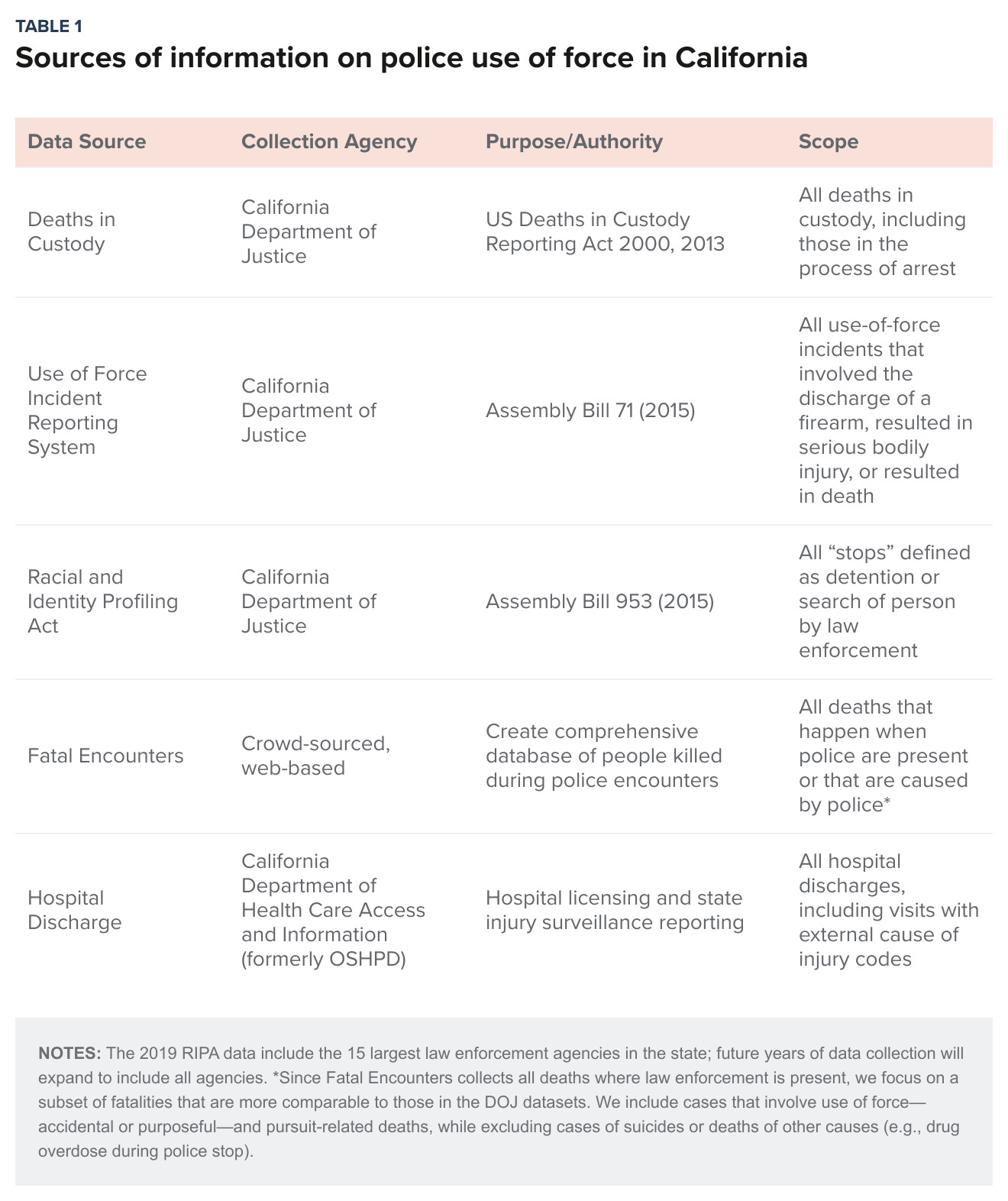
Below, we explore what the data tell us about use-of-force incidents that result in fatalities or serious injuries. While these data sources have various shortcomings, which we discuss below, these statistics can provide a baseline understanding of police use of force in California and offer insights on ways to improve the available information.
Nearly 200 People Die Each Year in Police Encounters
Figure 1 displays the annual counts of fatalities from law enforcement interactions from 2016 to 2019, as reported by three different data sources: the DOJ’s Deaths in Custody, the DOJ’s Use of Force data, and the crowdsourced Fatal Encounters. The two DOJ datasets are largely consistent with each other, indicating about 150 people, on average, are killed annually during encounters with law enforcement. The Fatal Encounters data include about 30 percent more fatalities, suggesting that 195 people die annually during police encounters. Importantly, these estimates do not indicate whether these deaths were considered the result of excessive or unreasonable uses of force—with many of them considered legally and procedurally justified.
California DOJ data sources record fewer civilian fatalities during police encounters than crowdsourced data
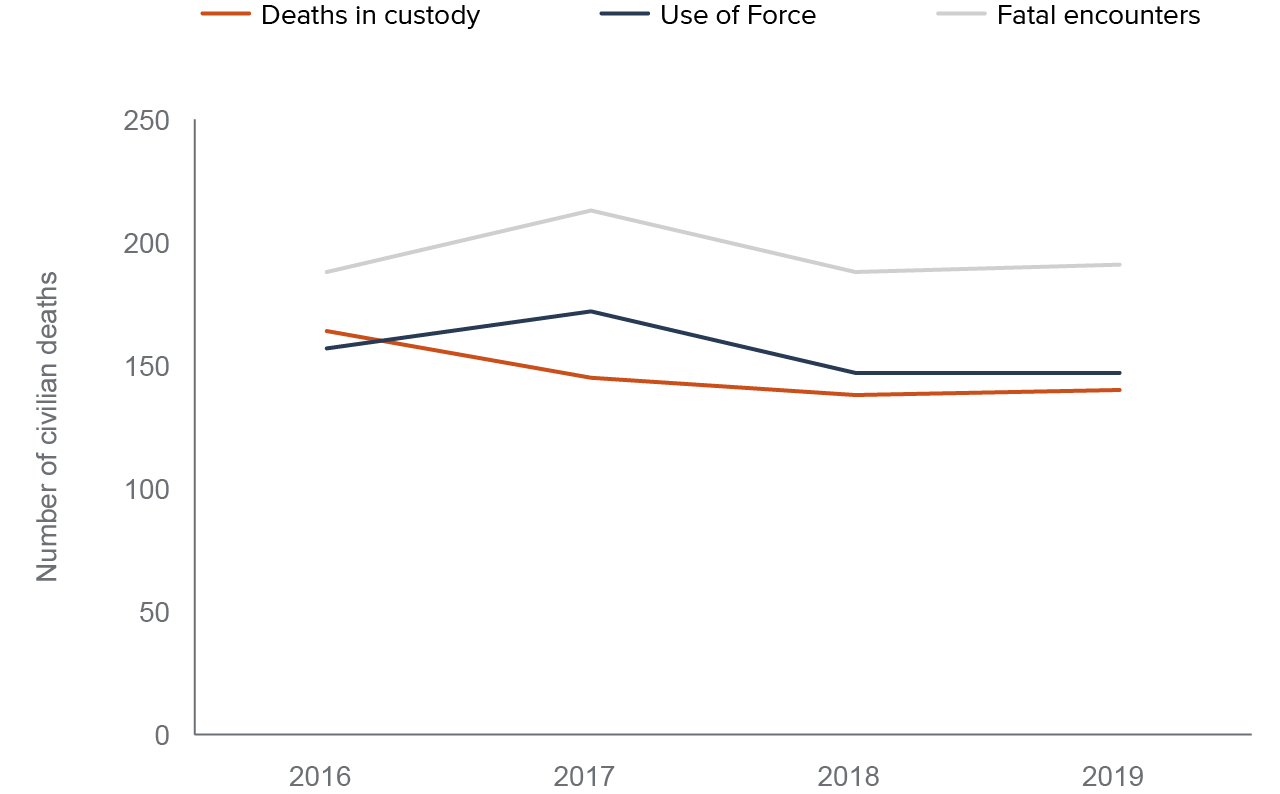
SOURCES: California DOJ, Use of Force data; California DOJ, Death in Custody data; Fatal Encounters data.
NOTES: Deaths in Custody counts only include arrest-related deaths. Use of Force and Fatal Encounters data exclude suicides.
We discuss potential reasons for the differences across sources below, but first we consider what these numbers suggest about the extent of civilian deaths during law enforcement encounters. Based on the figure of 195 fatalities documented in Fatal Encounters, these incidents account for nearly 10 percent of the number of annual homicides—including those that are considered lawful (e.g., in self-defense). At the same time, when we put these fatalities in the context of the large volume of arrests made each year in California (on average, about 1.2 million annually), this suggests about 16 fatalities per 100,000 arrests. Examining pedestrian and traffic stops among the 15 largest law enforcement agencies in the state suggests slightly over 2 fatalities per 100,000 police stops.
The differences between the DOJ sources and Fatal Encounters are mostly driven by the reporting of vehicle-related deaths. The Use of Force data do not include incidents where an officer accidentally kills a civilian with a vehicle (e.g., a high-speed chase that results in a fatal car crash), constraining serious use-of-force cases to ones that are intentional. Notably, the Use of Force data and Fatal Encounters both include fatalities that occur when officers are on duty and off duty, whereas Deaths in Custody only reports on-duty encounters; this might account for the lower number of fatalities recorded by Deaths in Custody for most years.
Figure 2 shows the cause of death recorded across the three datasets. Gunshots are by far the primary cause of death. The Fatal Encounters data indicate more than three-quarters of fatalities are the result of gunshot wounds, while the Use of Force data indicate 90 percent of fatalities result from gunshots. Deaths in Custody attributes about half of deaths to gunshots, though notably this dataset also includes a sizable share of fatalities (35%) that are still pending investigation. This tag of pending investigation is consistently reported from 2016 to 2019, suggesting that information on cause of death is not updated after investigations are completed—something to consider remedying in order to improve data quality. Currently, law enforcement agencies have up to 10 working days to report a death in custody to California DOJ, but there is no statutory requirement to update any missing information when an investigation is complete.
Gunshot wounds are the leading cause of fatalities during police encounters
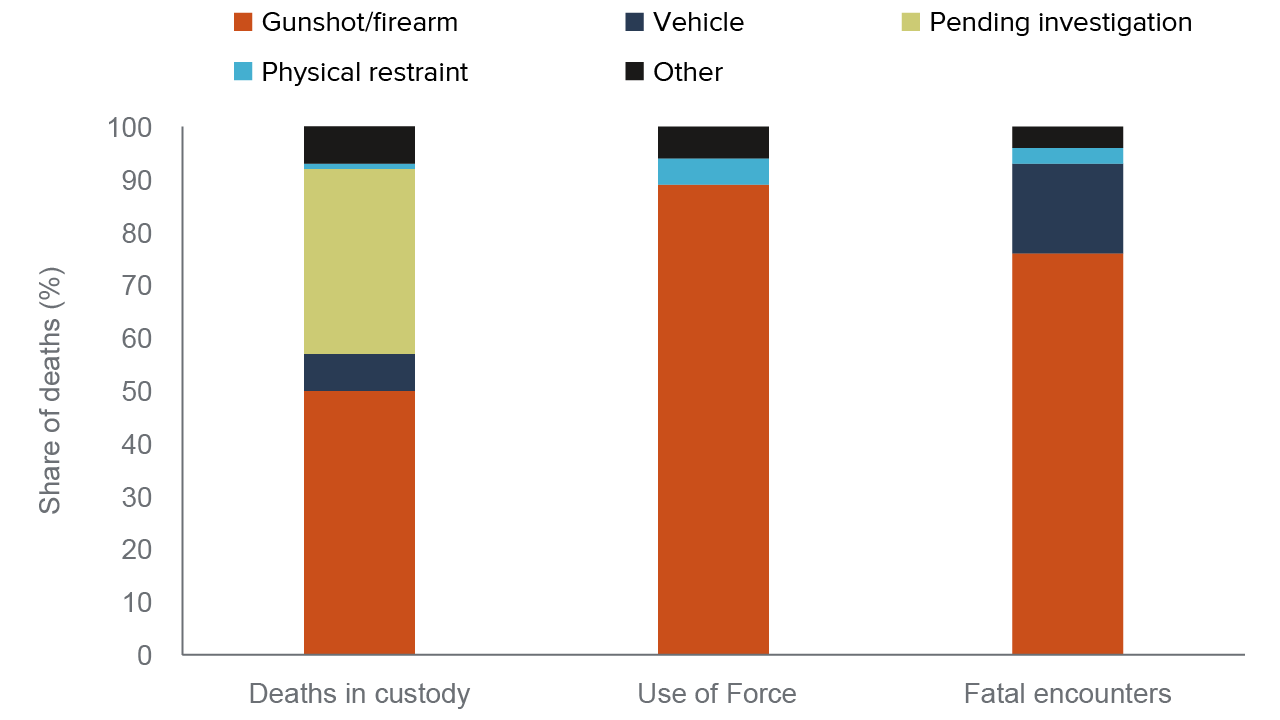
SOURCES: California DOJ, Use of Force data 2016–2019; California DOJ, Death in Custody data 2016–2019; Fatal Encounters data 2016–2019.
NOTES: This graph lists the most serious type of force used on an individual as the cause of death. Physical restraint includes fatalities caused by asphyxiation, blunt force trauma, and other forms of restraint.
Vehicle deaths—most often related to law enforcement pursuits and/or accidents—are a significant source of variation between Fatal Encounters and the two DOJ sources. About 17 percent of deaths reported in Fatal Encounters were vehicle-related, compared to about 7 percent in Deaths in Custody and no incidents in the Use of Force data, which does not seem to include any vehicle-related deaths as the highest level of force used, despite California Highway Patrol (CHP) being one of the primary reporting agencies. Reporters examining CHP data recently highlighted the underreporting of deaths from police pursuits or accidents when a law enforcement officer was driving. As the Use of Force data become the primary source for understanding police use of force in California, it would be helpful for lawmakers to ensure that the data encompass all instances when an officer’s actions result in serious bodily injury or death, including car accidents and pursuits.
Notably, Fatal Encounters reports a greater number of gunshot deaths than the Use of Force data (8.4% more), even though gunshot deaths represent a smaller share of all fatalities in Fatal Encounters compared to the Use of Force data. This is surprising, since the law governing the collection of the Use of Force data was designed to track all fatal shootings of civilians by officers—regardless of whether the officer was on duty or not. Using case details from Fatal Encounters and the Use of Force data could offer the California DOJ a method to perform some quality checks by matching incidents to determine where there are differences and whether those are attributable to the scope of data collection or underreporting.
Hundreds of People Are Shot or Seriously Injured in Police Encounters Each Year
According to the Use of Force data, about 250 gunshot injuries occur each year during police encounters, and more than half of these (57%) are fatal. The Use of Force data also indicate only half of people injured by a firearm during a police encounter receive medical treatment from a hospital or other medical facility; the remainder reportedly die in transit (38%), are treated at scene (9%), or do not receive or refuse medical aid (3%).
When we compare the number of gunshot wounds resulting in hospital treatment, as reported in the Use of Force data, with gunshot wounds in the hospital discharge data, we see similar patterns (Figure 3). However, there are slightly more non-fatal gunshot injuries according to the hospital data. Some of these differences likely result from how gunshot injuries are identified in the hospital data; since these data are reported in different ways and for different purposes, we do not expect them to be an exact match. See Technical Appendix A for additional details.
Gunshot injuries resulting from police encounters are similar across the Use of Force and hospital discharge data
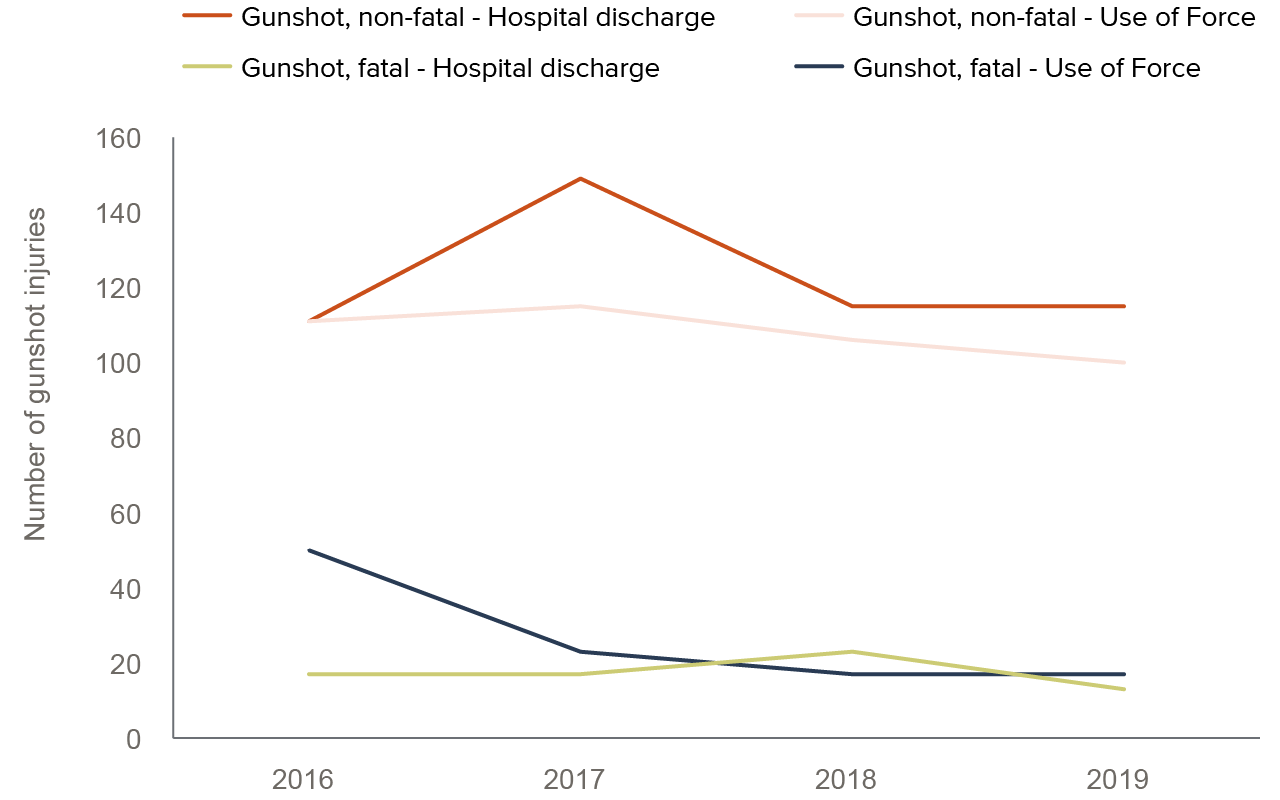
SOURCES: California DOJ Use of Force data; OSHPD hospital discharge data.
NOTES: Use of Force data only include gunshot wounds where the person injured was recorded as receiving medical aid at a hospital or medical facility. Gunshot injuries in hospital discharge data are based on external cause of injury codes indicating the injury resulted from a firearm encounter with law enforcement and excludes those that were not identified as serious based on the primary diagnosis. For more information, refer to Technical Appendix A.
The Use of Force data and hospital data also include other serious injuries resulting from police use-of-force incidents. According to the Use of Force data, there were about 365 additional serious injuries (excluding deaths and gunshot wounds) sustained during police encounters each year. Some of these injuries include lacerations, bone fractures, and head wounds. The hospital discharge data contain many more reports of serious injuries from police interactions—over 3,000 annually. They also include many more instances of lacerations, broken bones, and head wounds than are reported in the Use of Force data; however, it is not possible to determine how severe these injuries were based on the hospital records alone. The Use of Force data should include all injuries that result in “serious bodily injury,” making it difficult to compare directly with the hospital discharge records. Technical Appendix A provides more details on how we identify serious injuries in the hospital discharge data.
Understanding the Context of Police Use of Force
It is important to consider the circumstances under which police deploy serious use of force. While no data source can collect all of the necessary details, the hospital discharge data shed light on the potential role of mental health and substance use, while the Use of Force data and RIPA stop data provide additional insights into the criminal justice context.
Over Four in Ten Non-Fatal Gunshot Injuries Involve Behavioral Health Issues
What is the role of behavioral health conditions in police use of force—particularly incidents that escalate to serious injury or death? This question has become increasingly important, as many recent reforms focus on deploying social workers and crisis intervention teams in response to calls of people exhibiting signs of a mental health crisis, either to support or in lieu of law enforcement (Waters 2021). In California, the state legislature recently passed the Community Response Initiative to Strengthen Emergency Systems (CRISES) Act (Assembly Bill 118), which establishes a pilot grant program to support the transition of certain emergency services—such as those to support mental health or substance use crises—to community-based organizations; it was signed by the governor in October 2021. In addition, some law enforcement agencies have created officer training programs that focus on mental health and de-escalation techniques.
Both the Use of Force data and hospital discharge data provide information on the presence of behavioral health conditions. In the case of the Use of Force data, the information is based on the officer’s perception of a person’s behavior; in many cases, civilian behavior is simply described as ”erratic.” The hospital discharge data arguably provide a better measure of behavioral health conditions because they are based on diagnostic information assessed by a physician, most often an emergency department doctor.
Figure 4 compares reports of behavioral health conditions—including alcohol- and drug-use disorders and mental health conditions—for non-fatal gunshot injuries in the Use of Force and hospital discharge data. Among civilians with non-fatal gunshot injuries from a police encounter, the share with behavioral health issues was substantial; more than four in ten were identified as suffering from a mental health condition, having an alcohol- or drug-related disorder, or both, according to the hospital data. The Use of Force data show a slightly higher share with mental health conditions, with much of the difference attributable to officers indicating “erratic behavior” but not explicitly identifying it as related to either substance use or mental health. Of course, law enforcement officers do not have the same clinical tools to evaluate behavioral health conditions as health care professionals, but the hospital data do seem to confirm that many serious use-of-force incidents involve someone who is suffering from a behavioral health condition, which could escalate a police encounter.
Among civilians non-fatally shot by police, more than four in ten had behavioral health issues
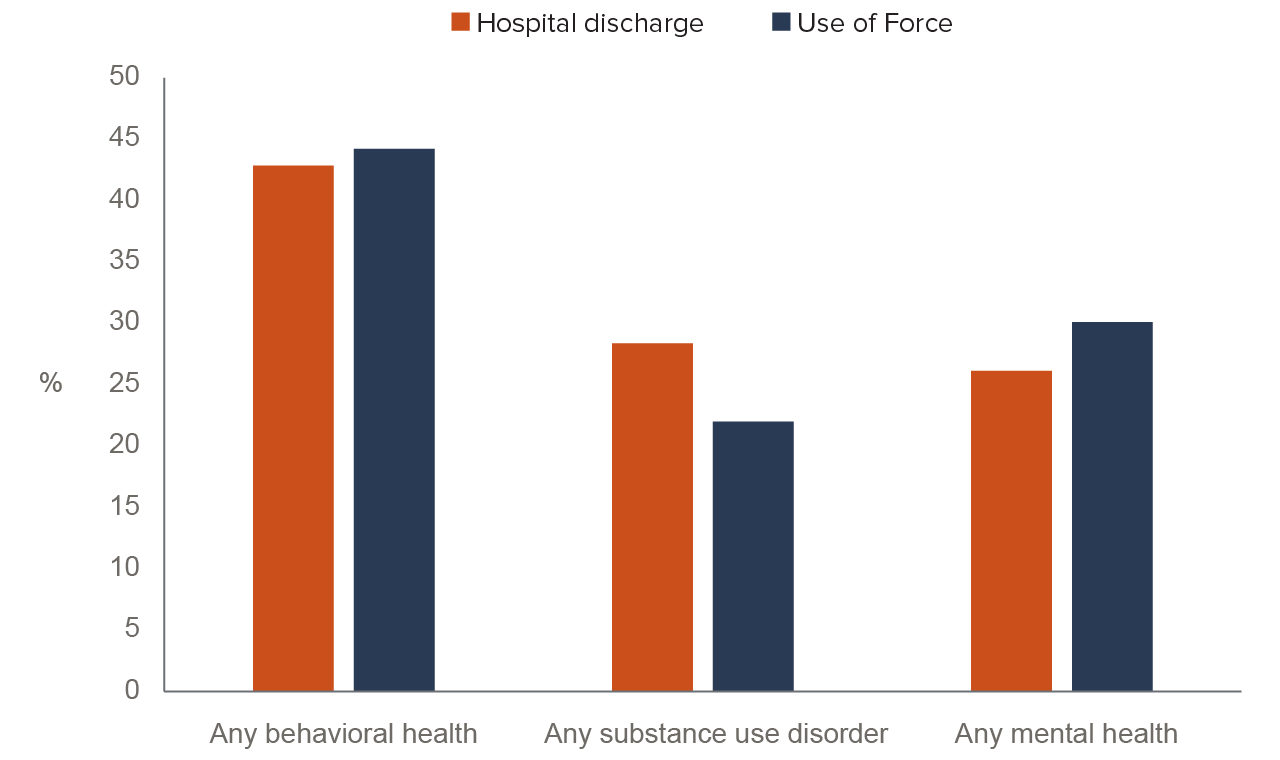
SOURCES: California DOJ, Use of Force data 2016–2019; OSHPD hospital discharge data, 2016–2019.
NOTES: Includes serious non-fatal gunshot injuries. Substance use includes both alcohol and drugs and excludes nicotine dependence. The share for any behavioral health is lower than adding the share with substance use or mental health, as some individuals have both conditions reported. For hospital discharge data, the presence of behavioral health conditions is based on the primary diagnosis and up to 24 additional diagnoses recorded in all emergency department and inpatient visits. The Use of Force measures for any behavioral health condition and any mental health condition include reports of “erratic behavior.” For more information, see Technical Appendix A.
Looking more specifically at substance use, which includes both alcohol- and drug-related disorders, there are more recorded instances of drug use (24%), with the most common drug by far being methamphetamines, followed by marijuana and opioids; alcohol disorder was recorded in about 9 percent of gunshot injuries. The hospital discharge data indicate about 26 percent of those treated for non-fatal gunshot wounds from a police encounter had a mental health condition, most often schizophrenia (9%) or suicidal ideation (4%).
Most Use-of-Force Incidents Occur after a Call for Service
The context in which law enforcement officers and civilians interact can vary substantially, and the Use of Force reporting system endeavors to collect important contextual factors, such as the reasons for police contact and the presence of weapons.
For incidents resulting in civilian death, gunshot injuries, or other serious injuries, reasons for police contact are similar across levels of injury severity (Figure 5). Calls for service were the primary reason law enforcement officers were on the scene for all serious use-of-force incidents. Typically initiated when someone calls 911 or a non-emergency line, calls for service can be for anything from noise disturbances or traffic complaints to the report of serious crimes like burglaries or assaults—accordingly, these incidents may represent a range of threat levels for officers.
Crimes in progress accounted for about 20 percent of incidents and was the next most-common reason police were on the scene. Pre-planned events, including serving arrest or search warrants and parole searches, comprised about 6 percent of reported incidents. In general, crimes in progress and pre-planned events tend to signal more dangerous environments for officers. Finally, about 15 percent of civilian deaths, gunshot wounds, and serious injuries incurred during encounters with police happened during vehicle and pedestrian stops—often lower-risk interactions (Technical Appendix Table A5), and notably, the ones that tend to give rise to racial disparities (Lofstrom et al. 2021). Nationwide, a few municipalities, such as Berkeley, California, and Brooklyn Center, Minnesota, have begun exploring the creation of a separate non-police agency to address traffic violations—by far the primary reason for vehicle stops in the state’s 15 largest law enforcement agencies, according to 2019 data from RIPA.
Calls for service are the most common reason for serious police use-of-force incidents
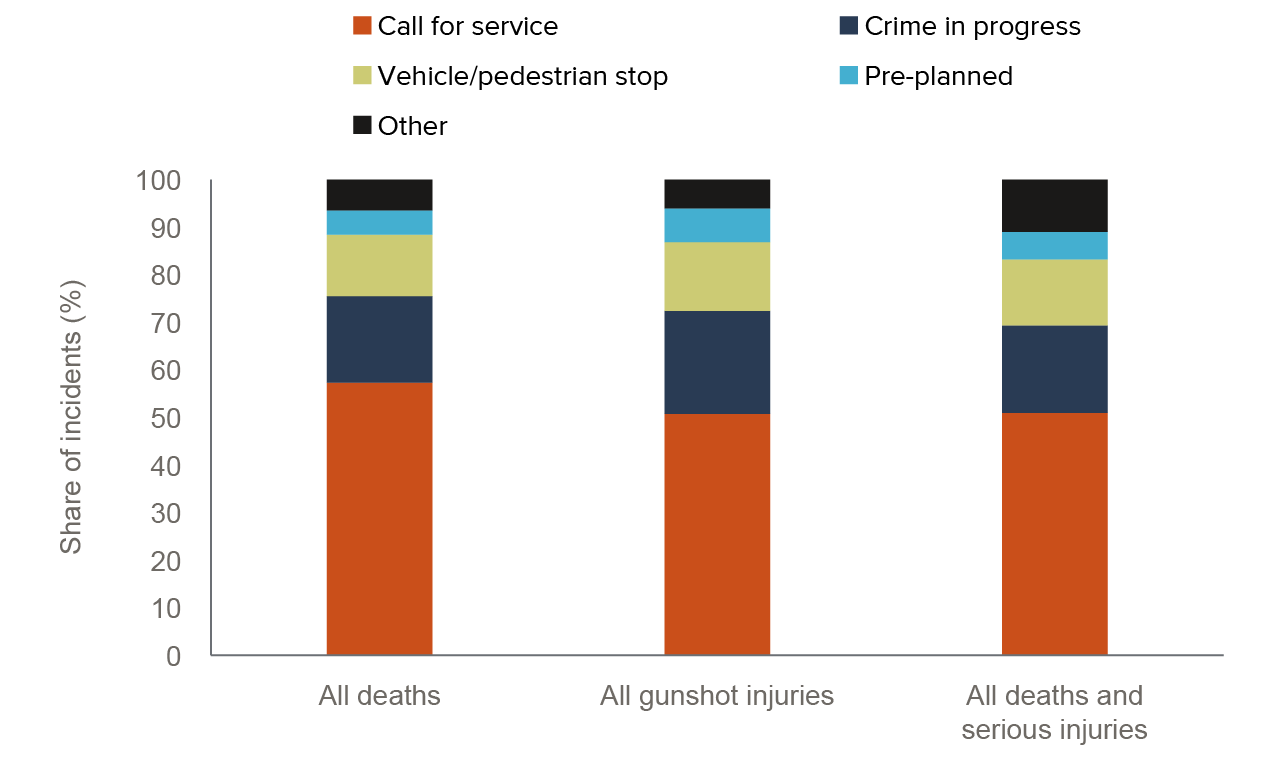
SOURCE: California DOJ, Use of Force data 2016–2019.
NOTES: Examples of pre-planned events include arrest/search warrants and parole/probation searches. “Other” includes welfare checks, in-custody events, and civil disturbances.
About 80 Percent of Fatalities and Gunshot Injuries Involve an Armed Civilian
Another critical contextual factor is whether the civilian is armed and may resist when stopped or arrested by police. Figure 6 presents the share of incidents in which the injured person was perceived and/or confirmed by the officer to be armed. In about 80 percent of deaths or gunshot injuries resulting from police encounters, the civilian was both perceived and confirmed to be armed with a dangerous weapon—most often a firearm (52%) or firearm replica (6%), followed by a knife or stabbing instrument (28% for deaths, 25% for gunshot injuries), or an unspecified dangerous weapon (11%). Among the remaining 20 percent of incidents resulting in deaths and gunshot injuries, it is evenly split between civilians who were perceived to be armed, but no weapons were found, and unarmed civilians who were never perceived to be carrying a weapon. There were a small percentage of incidents (2% to 3%) in which civilians were found to be armed, even though the officer did not perceive them to be armed at the time of injury.
The pattern looks somewhat different when we examine all serious injuries, including gunshot wounds and those that result in death, reported to the DOJ. The share confirmed armed with a dangerous weapon drops considerably: about four in ten civilians seriously injured during police encounters were perceived and confirmed armed, though a higher share (16%) were perceived to be armed. Strikingly, 56 percent of people who were seriously injured or killed during encounters with police were unarmed. Technical Appendix Table A2 provides additional information on armed status and types of weapons across the different injury severity levels.
In about 80 percent of incidents that result in death or a gunshot injury, the civilian was confirmed to be armed
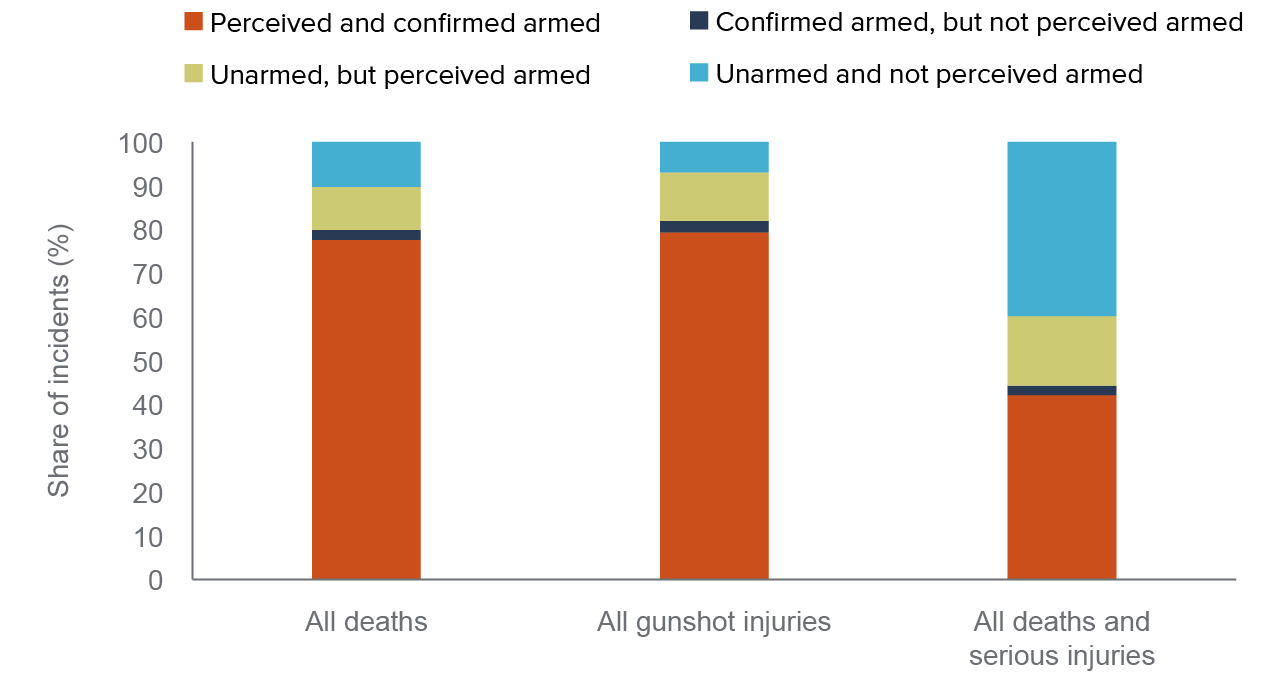
SOURCE: California DOJ, Use of Force data 2016–2019.
NOTES: Armed means that according to the reporting officer the civilian(s) involved in the incident was either confirmed or perceived to have some type of dangerous weapon. Officers report the type of weapon in one of these categories: firearm, firearm replica, knife or stabbing instrument, or other weapon.
According to the crowdsourced Fatal Encounters data, the share of fatalities involving an allegedly armed civilian is smaller, at about 65 percent, with firearms again being the most common weapon (about 60%). The differences between the civilian armed rates in the Use of Force data and Fatal Encounters are again driven by the fact that Fatal Encounters includes vehicle-related deaths, in which over 95 percent of civilians are unarmed.
Officers May Respond to Riskier Environments with Greater Force
The analysis above provides a baseline understanding of police use of force, and a breakdown of relevant factors that may contribute to it. However, it is difficult to draw conclusions about the role of situational factors from these state-level comparisons. Below, we explore additional contextual factors related to the jurisdiction where the incidents occurred. This analysis relies on the number of civilian fatalities from Fatal Encounters data and incorporates measures of crime rates, population size, and attacks on law enforcement officers into a regression framework to explore whether the application of deadly force varies with how risky the broader environment an officer may be working in is—a potential justification for the use of force in the first place (see Technical Appendix B for additional details and full results).
We find some evidence that the number of civilian fatalities during law enforcement encounters is correlated with higher-risk environments for policing. Within a jurisdiction, both the number of crimes using firearms (armed robberies and assaults) and assaults against officers are significant predictors of increased fatalities. This finding aligns with studies that show increased firearm prevalence is associated with more officers being killed (Swedler et al. 2015).
To further explore what may be driving these differences, we examine different kinds of civilian fatalities. We first explore what happens when we limit the set of fatalities in which the civilian was allegedly armed (65% of fatalities), compared to those in which the civilian was unarmed (35%). Focusing on the allegedly armed civilian fatalities, the estimates of assaults on officers and armed robberies and assaults are again significant predictors of fatalities within an agency.
Deaths of unarmed civilians in law enforcement encounters occur a bit more than half as often as incidents involving armed civilians, averaging about 0.267 instances per agency each year. Notably, the estimates of assaults on officers and crimes using firearms are not significant predictors of fatalities involving unarmed individuals (see Technical Appendix Table B2, Column 3). It seems straightforward that these factors representing “threat” are less relevant when predicting deaths of unarmed civilians compared to armed ones. But it is critical to understand factors that are predictive of these deaths, as these fatalities tend to be the ones that cause the most concern, and that communities and law enforcement agencies mutually agree are the most urgent to address (Premkumar 2019). To work toward independent oversight in these cases of force, California passed Assembly Bill 1506 in 2020, which requires the state DOJ to investigate all police shootings of unarmed civilians. Exploring this question with more contextual or agency data may shed light on what factors (e.g., behavioral health, poverty, and police trainings or procedures) are associated with deaths of unarmed people during police encounters.
Racial Disparities in Police Use of Force
The public’s and policymakers’ concern over police use of force, including the murder of George Floyd, often center on the disparate impacts on Black individuals and communities. These incidents generate the most public scrutiny, and more detailed information is necessary to develop policy solutions to mitigate any disparities (Premkumar 2019).
People of color, Black people in particular, are disproportionately represented at various points in the criminal justice system, including in interactions with law enforcement. Recent work focused on arrests as well as pedestrian and vehicle stops in California reveals large disparities. Black residents are three to four times more likely than white residents to be stopped and/or arrested by police (Lofstrom et al. 2019; Lofstrom et al. 2021). There are also differences between Latinos and whites in arrests, though they are considerably smaller in scale. Research focused on racial/ethnic disparities in use-of-force incidents in California using hospital discharge data found similar disparities for Black and Latino men (Mooney et al. 2018).
Black People Are Overrepresented in Police Use-of-Force Incidents
Figure 7 shows the racial distribution of all individuals seriously injured or killed in law enforcement interactions, along with their share of the state’s total population and their share of all law enforcement stops among the state’s 15 largest agencies. Black people are substantially overrepresented. In both the hospital data and the Use of Force data, Black people account for nearly 20 percent of serious injuries and fatalities, even though they comprise less than 6 percent of California’s population. As mentioned above, Black residents are much more likely to be stopped by the police (16% of stops) compared to their share of the population; this overrepresentation in police contact puts them at a greater likelihood of being subject to police use of force. The share of Black people among all serious injuries and fatalities (18% to 19%) is still larger than their share among all police stops, though this disparity is considerably smaller (Lofstrom et al. 2021).
Relative to their share of the population, Latinos are overrepresented in the Use of Force data, constituting about 45 percent of all incidents. But according to the hospital data, Latinos make up about 39 percent of patients injured by police, matching their share of the total population. In contrast, a smaller share of white people were seriously injured in police encounters (31% in the Use of Force data and 34% in the hospital data) relative to their share of the state’s population (37%). A similar story is true for Asians and Pacific Islanders, who comprise about 15 percent of the population, but only 2 to 3 percent of those seriously injured in interactions with law enforcement.
Figure 8 focuses specifically on civilians who were shot by police (either fatally or non-fatally) and indicates a similar pattern. Relative to their share of the state’s total population, Black people remain overrepresented, although this time to a slightly lesser degree, constituting 17 percent of both the Use of Force and hospital data. Latino people are also overrepresented, comprising about 45 percent (Use of Force data) and 44 percent (hospital data) of civilians who were shot. White people as well as Asians and Pacific Islanders are again underrepresented.
Finally, when we focus specifically on fatalities, Black and Latino civilians are overrepresented across all of our datasets. While Black people are about 6 percent of the state’s population, they represent between 16 and 19 percent of fatalities, similar to their share of arrests and stops. Latino people are also overrepresented but to a lesser degree: they account for about 45 percent of deaths from police encounters, but about 39 percent of California’s population. White people are slightly underrepresented, accounting for about one-third of fatalities, despite constituting about 37 percent of California’s population. Similarly, Asians and Pacific Islanders are also underrepresented, comprising about 4 to 5 percent of fatalities, while making up about 15 percent of the population.
Black and Latino individuals are consistently overrepresented among civilian fatalities in police encounters
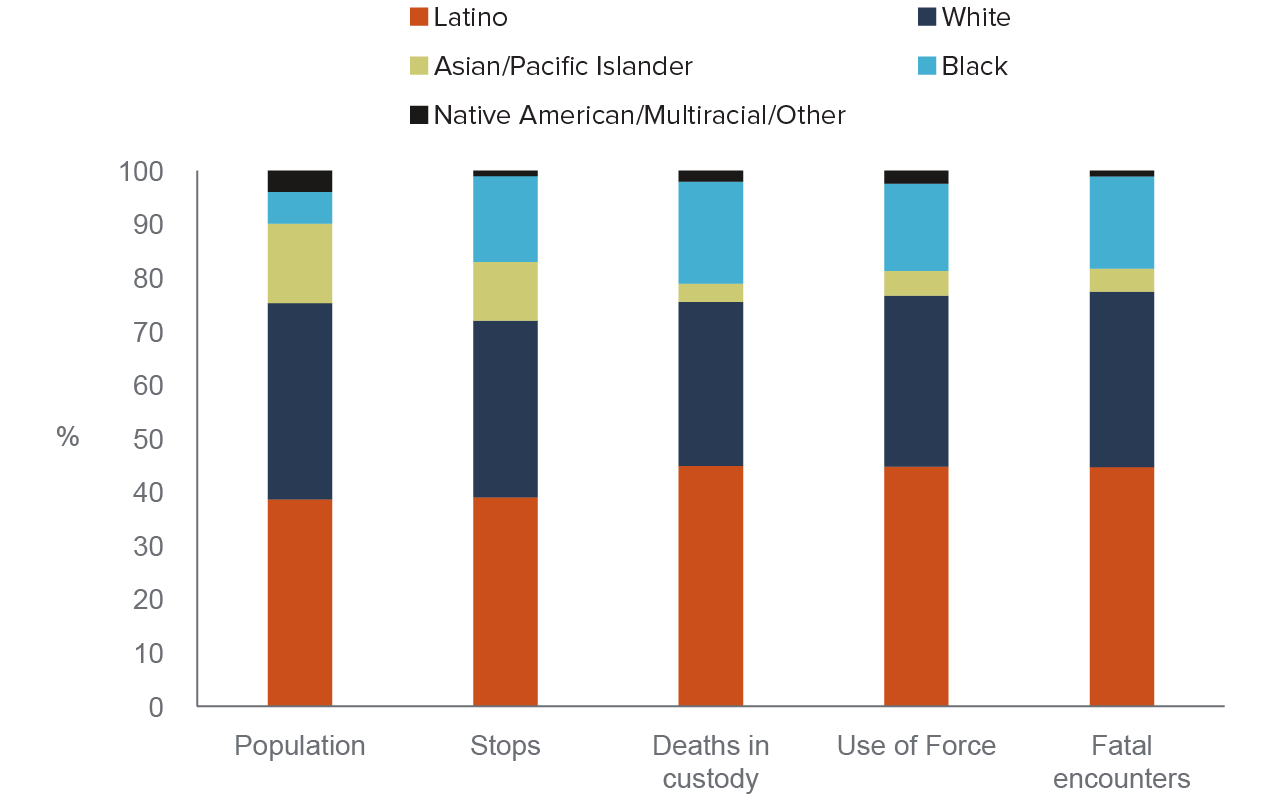
SOURCES: California DOJ, Death in Custody data 2016–2019; California DOJ, Use of Force data 2016–2019; Fatal Encounters data 2016–2019; California DOJ RIPA data 2019; American Community Survey 2019.
NOTES: Includes all deaths reported in the Fatal Encounters and Use of Force data, excluding suicides. Race/ethnicity is self-reported and/or based on administrative records in the Deaths in Custody and Use of Force data, and is based on news reports and researcher imputation in Fatal Encounters. The RIPA stop data contain both pedestrian and vehicle stops from the 15 largest agencies in California.
Racial Disparities Persist after Accounting for Several Factors
We use data from the Racial and Identity Profiling Act (RIPA) to examine whether contextual factors in individual police encounters help us better understand these racial disparities. RIPA requires California law enforcement agencies to collect detailed data on perceived characteristics of the civilians being stopped, the context in which the stop was made, and other information on what occurred in these stops.
The 2019 data contain around 4 million stops across the 15 largest law enforcement agencies in the state, and California Highway Patrol conducts about half of them. The more than 38,000 sworn, non-jail officers at those agencies comprise about 55 percent of law enforcement officers in California. Unlike the previous regression analysis, here we are able to directly control for some factors that may influence an officer’s decision to apply force in any given encounter—such as whether a weapon was found on a civilian—as well as adjust for other civilian characteristics, thus making a more “apples to apples” comparison between stops. Two important caveats: (1) All estimates are conditional on being stopped in the first place, which by itself has stark racial disparities that match what we find in use of force incidents (Lofstrom et al. 2021); and (2) all of the demographic information in RIPA is based on the officer’s perception of a civilian’s identity and relies strongly on the validity of the officer’s post-interaction reporting. Recent studies have found that, in certain contexts, law enforcement officers have misreported civilian race to evade detection of racial bias (Luh 2019).
With those limitations in mind, we use RIPA data because they contain granular information on perceptions of civilian identity (race, gender, age group, LGBT status, English proficiency, and disability), reason for the stop (call for service, traffic violation, reasonable suspicion, parole/probation supervision, knowledge of outstanding arrest warrant, and consensual encounter resulting in search), and action taken by an officer (from a search to being handcuffed). These interaction details are paired with a use-of-force continuum, ranging from removing the civilian from the vehicle to discharging a firearm. The RIPA use-of-force data are reported solely through actions taken by officers—and not injuries sustained by civilians—differentiating itself from the Use of Force data in all cases except where a firearm is involved. Subsequently, we focus the analysis on incidents where an officer aims or discharges a firearm at a civilian. Using the stop characteristics as controls, we explore whether racial disparities in use of force persist when comparing otherwise similar encounters (e.g., use-of-force rates between civilians of different races but same perceived age, gender, and reason for stop for a given agency).
As highlighted in Lofstrom et al. (2021), which relies on a similar methodological approach, we are not necessarily approaching an estimate of police bias when we increasingly control for more contextual factors. The RIPA data do not capture all relevant contextual information that prompted the stop and actions taken during it, potentially leading to an overestimate of bias (e.g., history of violent crimes or substance abuse). Conversely, officers self-report the data, allowing for purposeful misreporting (Luh 2019), and some of the factors that we use as controls may themselves represent bias (e.g., higher likelihood of Black people stopped for reasonable suspicion than whites). These factors would lead to an underestimate of bias. In totality, it seems plausible that the fully adjusted racial gaps represent a conservative, lower-bound estimate of racial bias in policing.
It is important to note that for all racial/ethnic groups, encounters in which a police officer aims or discharges a firearm are relatively rare. Among the 15 largest law enforcement agencies in the state in 2019, there were over 15,000 incidents where a police officer aimed a firearm at a civilian (0.4% of all stops) and about 150 incidents where an officer discharged a firearm (0.004% of all stops). However, given their grave nature, these relatively rare incidents can have serious consequences for the civilian and can negatively affect the broader community’s trust in law enforcement.
In Figure 10, we show the percentage point gap in use-of-force incidents involving a firearm between whites and the other racial/ethnic groups. In the raw (observed) data, before controlling for any contextual factors, we find a white person stopped by law enforcement faces a 0.23 percent likelihood (23 out of 10,000 incidents) that an officer will aim or discharge a firearm (Technical Appendix Table C1). For a Black person stopped by law enforcement, the likelihood that an officer will aim or discharge a firearm is 0.52 percentage points higher, or 0.75 percent (75 out of 10,000 incidents). Put differently, Black people who are stopped by police are over 3.2 times as likely (i.e., over 220% more likely) to have an officer aim or discharge a firearm at them than whites. Though these differences are most prominent for Black people, Latinos, Native Americans, and multiracial civilians are all almost 90 percent more likely to be in encounters where the police aim or discharge a firearm compared to white residents. We actually see that Asians and Pacific Islanders are 38 percent less likely to be involved in police encounters involving a firearm compared to white residents.
Racial disparities in incidents where an officer aims or discharges a firearm
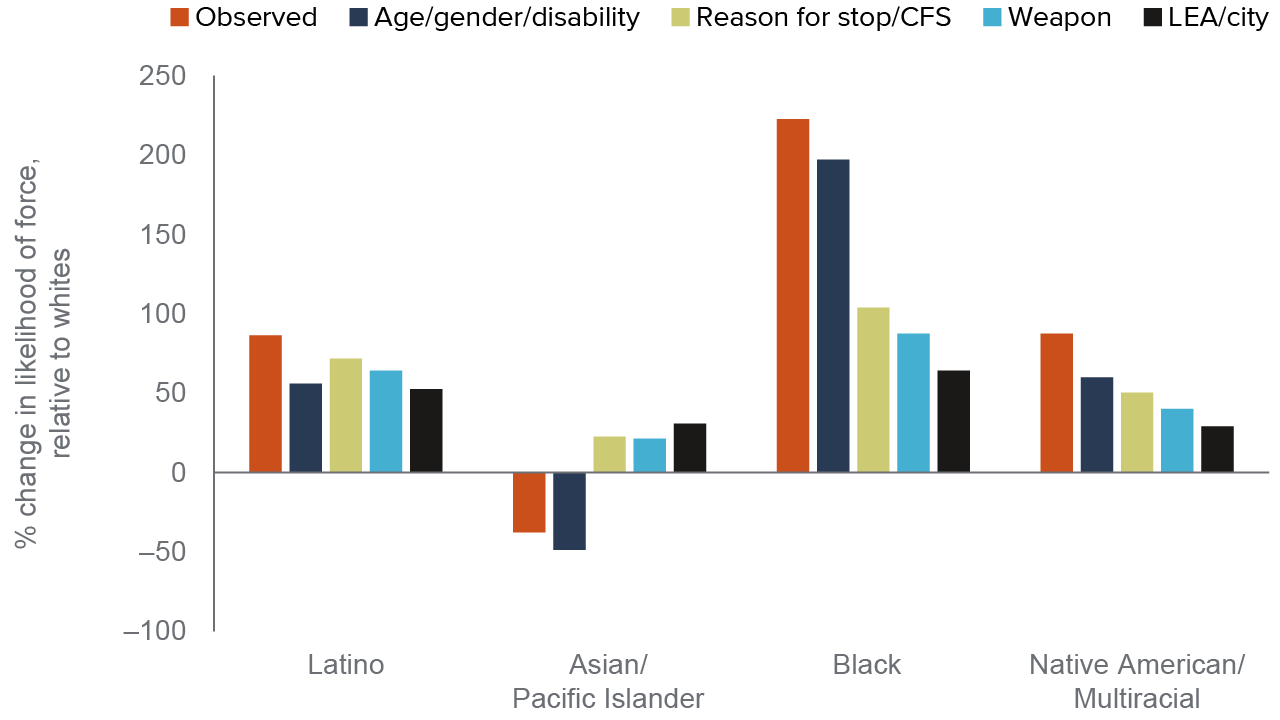
SOURCE: Authors’ estimates using California DOJ, Racial and Identity Profiling Act (RIPA) Wave 2 data, 2019.
NOTES: All estimates are statistically significant at the 95 percent confidence level. The bars represent differences in the likelihood of an officer pointing or discharging a firearm at a civilian when they are white compared to the corresponding racial/ethnic groups, sequentially adding more controls. CFS refers to call for service. The stop data are limited to the state’s 15 largest law enforcement agencies (LEA): California Highway Patrol, the police departments of the cities of Los Angeles, San Diego, San Francisco, Fresno, Long Beach, Oakland, Sacramento, and San Jose and the sheriff departments of Los Angeles, San Bernardino, Riverside, San Diego, Orange and Sacramento Counties. Detailed regression results are presented in the Technical Appendix Table C1.
The racial differences in the probability of an officer pointing or discharging a firearm narrow as we consecutively add more controls to account for additional details about the police encounter and perceived characteristics of the civilian. Accounting for the perceived gender, sexual orientation, age, English proficiency, and disability of the person being stopped reduces the Black-white gap: Black people are now 197 percent more likely to be in an incident involving an officer’s firearm, with similar drops for other racial groups who experience more force than whites.
Since there is substantial variation across racial groups in the reasons why people are stopped (Lofstrom et al. 2021), with Black people overrepresented in stops prompted by reasonable suspicion or an outstanding warrant, it is also important to examine how the gap changes after controlling for the reason for stop and whether the stop was prompted by a call for service. Adjusting for these contextual factors, the change in the force gap differs by racial group. Strikingly, the gap becomes positive for Asians and Pacific Islanders, where they are 23 percent more likely than whites to have an officer aim or discharge a firearm after being stopped. This suggests that the reasons why people in these groups are stopped differ from those of other groups, and this difference may have been driving the reduced likelihood of being in an incident involving an officer’s firearm that we observe in the raw data. Similarly, the Latino-white gap also grows to 72 percent. In contrast, the Black-white gap is drastically lessened to 100 percent.
Another important consideration in use-of-force incidents is assessing the threat level law enforcement officers may perceive or face, which could influence decisions made about the type and level of force applied. Lofstrom et al. (2021) illustrate that Black people are searched more often, and subsequently, officers are more likely to find contraband and evidence on them during a stop compared with white people. However, when focusing strictly on searches, contraband is discovered less often relative to white people and most other racial groups. After controlling for whether the stops resulted in a discovery of a weapon, the racial gaps decline moderately for nearly all groups, yet we still find that Black people are 87 percent more likely than white people to be involved in an incident involving an officer’s firearm.
There is sizeable variation in policing strategies and practices across law enforcement agencies and cities. Lofstrom et al. (2021) show different agencies tend to stop people for different reasons—for example, Oakland and San Diego Police Departments primarily initiate stops based on reasonable suspicion, while traffic violation is the stated reason for all other departments. To the extent that these agencies and localities have differing demographic compositions or contextual factors that affect policing, it is important to explore whether the racial gap in force exists within an agency and the closest city where the stop was made. When adjusting for the agency and closest city, in addition to the previous controls, the racial gaps remain statistically significant and positive for all racial groups. In this model, we still find that officers are 64 percent more likely to point or discharge their firearms at Black people than white people—the largest gap among racial/ethnic groups. The smallest gap is 29 percent for Native American and multiracial residents.
Again, we should not consider the most restrictive model to be the true estimate of racial difference in use of force; however, it is plausible that the fully adjusted gaps represent a conservative, lower-bound estimate of racial bias in policing. Moreover, these final estimates show us how persistent the racial disparities in police use of force are—even after controlling for numerous characteristics about the civilian, context in which the stop was made, threat faced by an officer from a weapon, law enforcement agency, and closest city—although these disparities do narrow when adjusted for these contextual factors.
Police Misconduct in California
In this section, we review the available information on police misconduct in California. As discussed above, most use-of-force incidents are not considered misconduct. Moreover, misconduct may not involve the use of force at all. Misconduct includes any incidents deemed outside of the officer code of conduct—whether the officer is on duty or off duty—including obstructing justice, driving under the influence, or engaging in other illegal acts. Here we consider all types of misconduct, including those not related to use of force, because these can also damage the public’s trust in law enforcement.
Though officers are legally able to use force to enforce the law, use of force can be deemed excessive and/or unreasonable depending on the circumstances of the interaction. While use of force and misconduct are not the same thing, the potential overlap between the two provided the impetus for recently enacted state legislation (Senate Bill 1421) and proposed federal legislation (George Floyd Justice in Policing Act), both of which called for increased data availability and transparency for use-of-force incidents and cases of misconduct. In addition, other legislation in California aims to increase transparency and heighten accountability for police misconduct. For example, the recently introduced Assembly Bill 718 and the recently signed Senate Bill 2 would work to stymie the “wandering officer” phenomenon, when officers who commit misconduct move from agency to agency to evade consequences.
These efforts follow years of reform. In 2018, Senate Bill 1421 was passed to increase record transparency in policing by allowing the Public Records Act to apply to incidents where (1) an officer uses serious force, defined as a discharge of a firearm or any action that causes great bodily injury or death, or (2) an officer commits misconduct through a sustained finding of sexual assault or dishonesty in the reporting, investigation, or prosecution of a crime or misconduct. In addition, recently Attorney General Bonta vowed to increase transparency and committed to a court-mandated expedited release of records in response to a KQED lawsuit.
Broadly speaking, law enforcement officers have significant civil, criminal, and employment protections (Schwartz 2014; Rushin 2017; Rushin 2019; Grunwald and Rappaport 2020; Rushin 2020). Outside their initial probationary period when they first join the force, firing or demoting patrol officers is quite difficult, since they usually are protected through union contracts (Rushin 2017; Rushin 2019; Rushin 2020). Arguably more troubling, officers who are fired can end up rehired in nearby jurisdictions, as access to complaint, misconduct, and disciplinary records are restricted under a common set of state laws, including from prosecutors, public defenders, and even other police departments (Bies 2017; Kelly, Lowery, and Rich 2017; Grunwald and Rappaport 2020). For example, before the passing of Senate Bill 1421, organizations like the ACLU considered California one of the most opaque states regarding public access to these records, prohibiting even prosecutors from accessing them except in special circumstances (Bies 2017).
For these reasons, the few datasets that currently exist on police misconduct tend to be limited to rare adverse consequences: decertifications/revocations of officers’ basic certificate, moral character violations, or arrests of police officers. Before the passage of Senate Bill 2 in September 2021, California was one of three states whose Peace Officer Standards and Training (POST) commission did not have the power to decertify officers. According to a public database created by USA Today documenting the decertifications of over 30,000 law enforcement officers from 44 states, the top reasons for decertification were misconduct related to drugs and alcohol (~22%), assaults and violence (16%), and dishonesty (13%).
Assault Is the Most Common Reason Officers Are Arrested in California
The most detailed public data on police misconduct is the national Police Crime Database, created by Professor Phillip Stinson (hereafter, the Stinson dataset). The data contain demographic information on the officer and the victim (though this information is inconsistently known/reported), the officer’s rank and agency, the date of the incident, the offense, and finally the employment and criminal consequences. It is important to note that the Stinson data likely undercount instances of misconduct for two reasons. First, the data are collected mainly through crowdsourced methods involving Google Alerts and news search engines. Second, the data only capture arrests of police officers and thus misses misconduct cases that could be revealed from additional access to personnel records, lawsuit settlements, and the like. As discussed previously, officers have certain privileges that protect them from civil, criminal, and employment consequences. These privileges also reduce their likelihood of being arrested in the first place.
There were at least 824 arrests of law enforcement officers in California from 2007 to 2016, slightly over 82 per year; this means of the almost 78,400 law enforcement officers in California during that time, 0.1 percent were arrested annually. On average, arrested officers were men with about 10 years of experience, and they typically held the lowest rank (e.g., patrol, deputy sheriff, or trooper) (see Technical Appendix Table D1 for more). The arrests were for 50 different offenses, but a majority of arrested officers faced charges related to violent or sex crimes.
The left columns of Table 2 show the most common offenses in these arrests and their share of total arrests. Aggravated assault is the most common reason officers are arrested in California (85 arrests from 2007 to 2016, or 10% of all arrests), with simple assault as a close second. Arrests for aggravated assault and simple assault could refer to use-of-force incidents, as could arrests for manslaughter or murder, though the latter two do not appear in the top ten offenses. While officers are legally able to use force to enforce the law, in these cases, the use of force may have been deemed excessive and/or unreasonable given the context of the interaction.
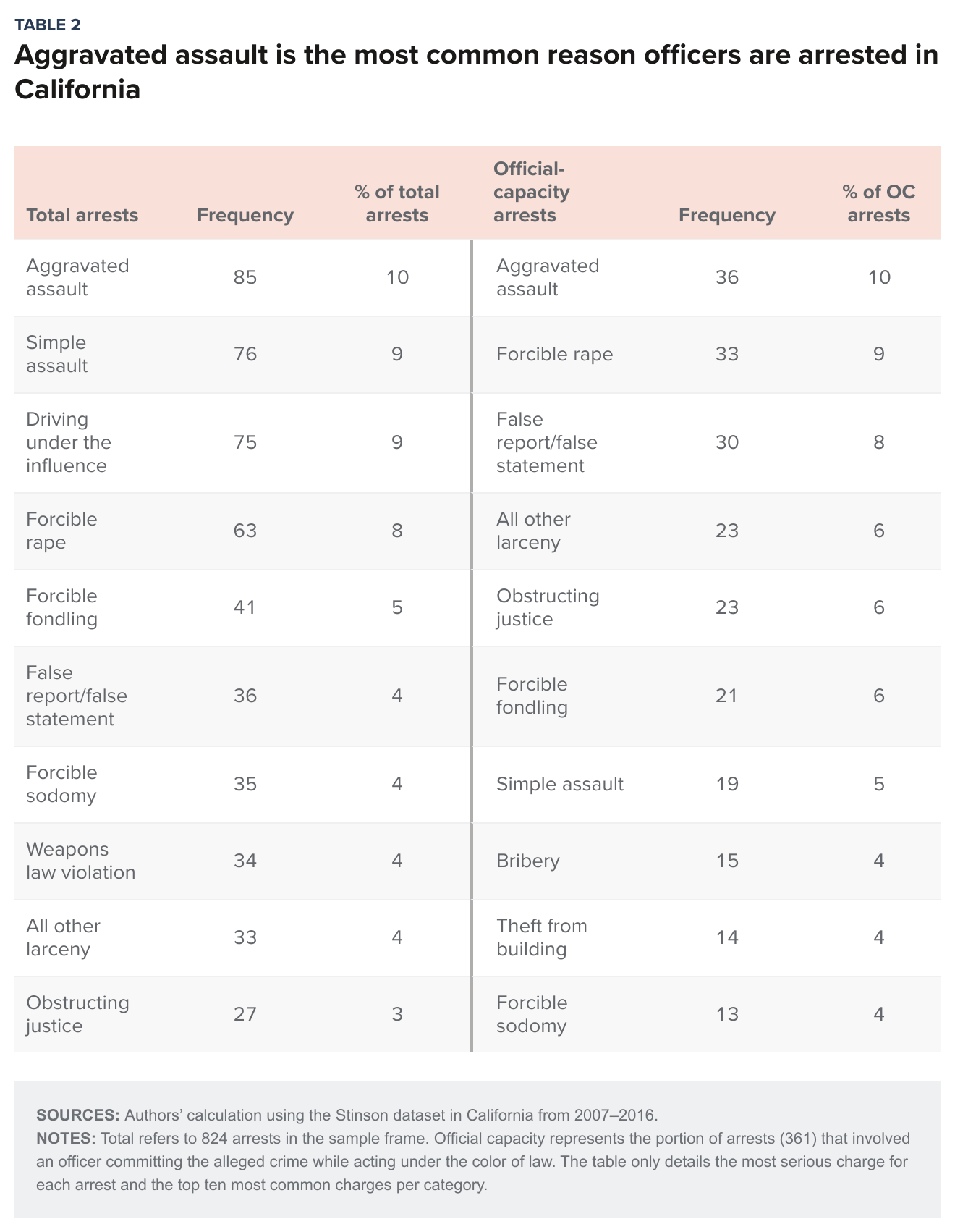
Sex crimes account for three of the top ten offenses; it is important to note that previous research highlights how underreported sex crimes are—and underreporting may be more common when the crime is committed by law enforcement (Allen 2007; Anderson and Beck 2021). Two other notable charges are providing a false report/statement and obstructing justice, incidents that could be available via public records requests under Senate Bill 1421, but in these cases, the offense was serious enough that it warranted arrest.
The right columns of Table 2 focus on a subset of arrests (361, or 44% of the total) for alleged crimes that took place when the officer was acting in an official capacity (OC), meaning they were either on duty—as was the case 89 percent of time—or they showed their badge, conducted a search, or identified themselves as a law enforcement officer. Many of the violent and sex crimes remain part of the top ten most common charges that officers face when arrested. Notably, crime types related to corruption or dishonesty such as false reporting, obstructing justice, and bribery are more common among OC arrests.
Most commonly, the officer’s own employing agency performed the arrest. In 70 percent of arrests, the agency fired the officer or they resigned afterward (Technical Appendix Table D2). Only in 9 percent of arrests was no employment action taken. For the incidents where the criminal case outcome is known (over 80% of them), officers were convicted in 76 percent of cases—a majority of which were felony convictions (62%), which would disqualify them as peace officers if reliably reported to POST. Nearly 75 percent of those convicted faced some jail or prison time, averaging out to about 8.1 years per incident, with wide variation in sentencing length. See Technical Appendix Table D2 for more details.
Even in high-profile cases of civilian fatalities during police encounters, it is rare for officers to face criminal charges, and even rarer for them to be convicted. Cross-referencing cases between the Stinson data and Fatal Encounters, we are able to evaluate the number of civilian fatalities that resulted in arrests. In California from 2007–2016, Stinson data identify 20 incidents where an officer was arrested and the victim suffered fatal injuries—15 of which were committed when the officer was acting in an official capacity. Over the same period, there were 2,075 civilian fatalities during police encounters, suggesting that 0.72 percent of these fatalities resulted in an officer being arrested (see more details about this calculation in Technical Appendix D). When focusing just on deaths of unarmed civilians, arrests occur in about 1.2 percent of incidents. As mentioned above, most instances of police use of force are considered legally and procedurally justified. Without more contextual information, it is impossible to know what the appropriate reference point is—the number of fatalities that should result in the arrest of the officer.
Using coarse measures such as population, California is underrepresented in the Stinson data, comprising almost 7 percent of the nation’s arrests of law enforcement officers, but almost 12 percent of the population. That may change as increased scrutiny around police use of force could shift decisions on whether to prosecute certain cases, especially in the backdrop of Assembly Bill 392, which narrows the acceptable uses of deadly force, and Assembly Bill 1506, which requires that the state attorney general investigate all police shootings of unarmed civilians. Moreover, reporting and access to data should soon expand due to recent legislation signed by Governor Newsom in September 2021: Assembly Bill 26 requires an officer to immediately report and intercede in potential excessive use-of-force cases, specifying consequences if they do not. Senate Bill 16 mandates that sustained findings of unreasonable or excessive use of force, unlawful arrests or searches, and discrimination/prejudice are subject to disclosure. On the other hand, use-of-force patterns themselves may change as more law enforcement officers complete training on how to modify their procedures and tactics to comply with the new standards. Using data from POST, CalMatters recently reported that as of May 2021 only 12 percent of law enforcement officers have finished the two-hour, state-certified course.
Given the need for robust and detailed data sources to understand whether these policy changes affect excessive use of force, the Stinson dataset can serve as a framework for California for how to structure de-identified, public records on police officer misconduct. Continuing the trend it set with the public collection and release of data on CA DOJ’s OpenJustice portal, California can become a paragon for the rest of the country in terms of data transparency on police misconduct, providing a model of how to structure a comprehensive and publicly available database on police misconduct incidents.
Conclusion and Recommendations
Growing concern among policymakers and the public alike over civilian deaths—disproportionately people of color—at the hands of law enforcement has increased scrutiny on police use of force and misconduct, heightening calls for greater transparency and accountability. Following several years of reform, California has become a bellwether for data transparency in policing with the creation of the OpenJustice portal and new reporting requirements for law enforcement agencies. Examining the scope and quality of the existing data—both what they can tell us and what they cannot—can help guide improvements in the currently available information and shape future data collection efforts.
One important question concerns the quality of the data collected by the California Department of Justice on police use of force and deaths in custody. Based on comparisons with crowdsourced data from Fatal Encounters and hospital discharge data, we find the DOJ data capture the majority of deaths that occur during police interactions, with the notable exception of many vehicle-related deaths and a smaller number of gunshot deaths. Routine audits using other data sources for comparison would help improve data quality, and clarifying the types of incidents that should be included in the Use of Force reporting system could make this effort more comprehensive. To this end, the state legislature should consider amending the statutory language governing the Use of Force data to ensure it encompasses all instances where an officer’s actions result in serious bodily injury or death, including car accidents or pursuits. Additionally, the state should consider mandating that all agencies update the Deaths in Custody data after an investigation is complete.
We also examined how the risky environments faced by law enforcement officers are correlated with the nearly 200 fatalities that occur during police encounters across California each year. We do find some associations between fatalities and measures of higher-threat environments, like the number of armed robberies and assaults on officers within a jurisdiction. However, additional work needs to be done to better understand contextual factors related to civilian fatalities and other serious injuries—particularly those of unarmed individuals. The Use of Force data show that 56 percent of civilians who are seriously injured or killed in police encounters are unarmed. Since 15 percent of these incidents occur during vehicle and pedestrian stops, typically lower-risk interactions, it is worth exploring how to reduce these encounters without affecting public safety. Reducing these encounters may also help narrow racial disparities: recent research highlights how racial disparities are largely driven by these stops, particularly traffic violations (Lofstrom et al. 2021). As a few communities across the country, such as Berkeley, California, and Brooklyn Center, Minnesota, consider separating their traffic enforcement from their police department, it will be imperative to analyze the effect of such reforms on use of force, public safety, and the associated racial disparities in both.
Addressing stark racial disparities in police interactions and use of force, particularly for Black people, will be vital. Across multiple data sources, we find large disparities across racial/ethnic groups in their likelihood of being injured or killed during a police encounter. Our analysis of new data on police stops further shows that, although disparities narrow when we control for certain factors, they cannot be explained by demographics, reason for the stop, whether a weapon was found on the civilian, the agency, or the closest city. As the state works to implement training related to the new deadly force standards (Assembly Bill 392) and to investigate fatal police shootings of unarmed civilians (Assembly Bill 1506), it will be important to understand how these shifts affect the racial disparities in use of force. As recent PPIC research has shown, race-neutral policies such as Proposition 47 can lead to meaningful reductions in racial inequities in the criminal justice system (Lofstrom, Martin, and Raphael 2020).
Given the high prevalence of behavioral health issues in cases where people are injured by police, policies that seek to deploy other resources, like social workers or crisis counselors—either in addition to or in lieu of police—could help prevent or lessen the use of force in these encounters. Recently passed state legislation (Assembly Bill 118) will create pilot projects and distribute grants to organizations providing community-based alternatives to law enforcement in response to crisis situations. Interventions to expand health care for those who have mental health conditions may produce “double dividends,” as they may also lead to reductions in crime (Jácome 2020). As these pilot programs move forward, rigorous evaluation studies should be conducted in order to assess their impact on use of force and racial disparities in police interactions, along with outcomes like arrests and hospital visits.
Finally, the crowdsourced Stinson data on arrested police officers shed some light on police misconduct, an area for which comprehensive information is still sorely lacking. The Stinson data include details about the arrest and charge, officer characteristics, criminal case outcomes, and resulting legal consequences for arrested officers—offering a model for how a detailed database on police misconduct could be structured. Some of this information may soon become more available as California continues implementation of Senate Bill 1421, which should expand access to police records related to use-of-force incidents and misconduct through public record requests. As state policymakers continue to debate issues around police decertification and other law enforcement accountability measures, having more resources to track the scope of police misconduct will be critical.
Recent state legislation has heralded a new age of accessible, government-sourced data on police use of force in California. As the state considers additional reforms that would increase transparency and heighten accountability when a law enforcement officer commits misconduct, this report illustrates how existing data can be used to inform policy and practice, and how these data can be improved. As more information becomes available, researchers, stakeholders, and practitioners can work toward developing the evidence-based policy suggestions that are needed to guide conversations on this timely and heated topic.
Topics
Criminal JusticeLearn More

Arrests in California
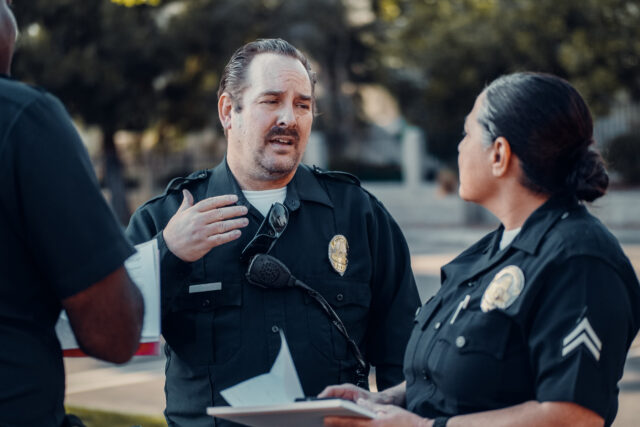
Law Enforcement Staffing in California

Racial Disparities in Law Enforcement Stops

Racial Disparities in Traffic Stops
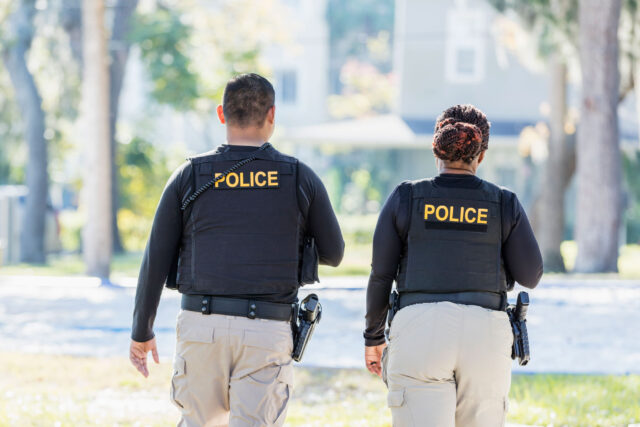
Historic Law Aims to Improve Police Accountability and Transparency
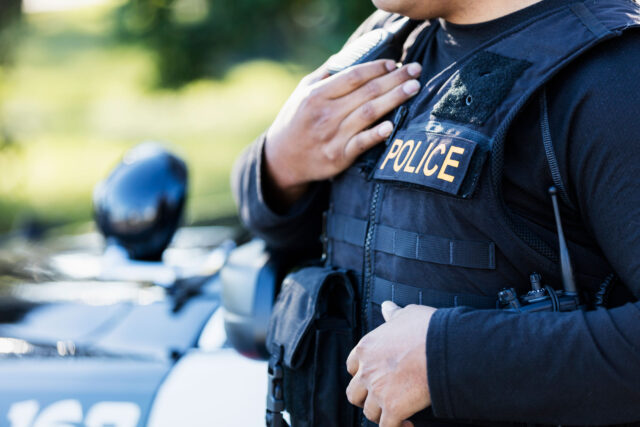
New Law Raises Standards for Police Officers
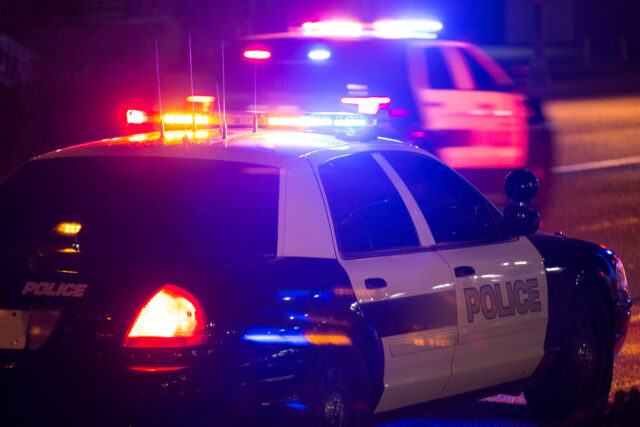
Police Use of Force and Racial Disparities during Traffic Stops

Video: Policing in California



